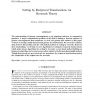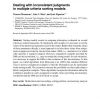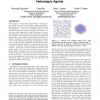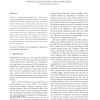CORR
2004
Springer
14 years 3 months ago
2004
Springer
Sorting by reversals is an important problem in inferring the evolutionary relationship between two genomes. The problem of sorting unsigned permutation has been proven to be NP-ha...
JCB
2007
14 years 3 months ago
2007
The understanding of genome rearrangements is an important endeavor in comparative genomics. A major computational problem in this field is finding a shortest sequence of genome...
FUIN
2008
14 years 3 months ago
2008
Spiking neural P systems simulate the behavior of neurons sending signals through axons. Recently, some applications concerning Boolean circuits and sorting algorithms have been pr...
4OR
2006
14 years 3 months ago
2006
Sorting models consist in assigning alternatives evaluated on several criteria to ordered categories. To implement such models it is necessary to set the values of the preference p...
CPHYSICS
2008
14 years 3 months ago
2008
Given the resurgent attractiveness of single-instruction-multiple-data (SIMD) processing, it is important for high-performance computing applications to be SIMD-capable. The Hartr...
BMCBI
2010
14 years 3 months ago
2010
Background: Protein sorting is the process that newly synthesized proteins are transported to their target locations within or outside of the cell. This process is precisely regul...
SAC
2010
ACM
14 years 3 months ago
2010
ACM
Cell sorting is a fundamental phenomenon in morphogenesis, which is the process that leads to shape formation in living organisms. The sorting of heterotypic cell populations is p...
AAAI
2010
14 years 4 months ago
2010
Kernelized sorting is an approach for matching objects from two sources (or domains) that does not require any prior notion of similarity between objects across the two sources. U...
SPAA
1995
ACM
14 years 6 months ago
1995
ACM
We study the problem of sorting on a parallel computer with limited communication bandwidth. By using the PRAM(m) model, where p processors communicate through a globally shared me...
ACSC
2003
IEEE
14 years 6 months ago
2003
IEEE
Sorting is a fundamental algorithmic task. Many generalpurpose sorting algorithms have been developed, but efficiency gains can be achieved by designing algorithms for specific ki...




